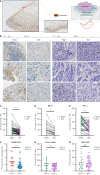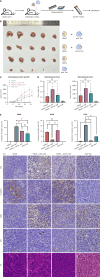Macrophage-derived cathepsin L promotes epithelial-mesenchymal transition and M2 polarization in gastric cancer
- PMID: 39713169
- PMCID: PMC11612860
- DOI: 10.3748/wjg.v30.i47.5032
Macrophage-derived cathepsin L promotes epithelial-mesenchymal transition and M2 polarization in gastric cancer
Abstract
Background: Advanced gastric tumors are extremely prone to metastasize the in 20%-30% of gastric cancer, and patients have a poor prognosis despite systemic chemotherapy. Peritoneal metastases from gastric cancer usually indicate the end stage of the disease without curative treatment.
Aim: To peritoneal metastasis for facilitating clinical therapy are urgently needed.
Methods: Immunohistochemical staining and immunofluorescence staining were used to demonstrate the high expression of cathepsin L (CTSL) in human gastric cancer tissues and its localization in cells. Lentivirus transfection was used to construct stable cell lines. Transwell invasion assays, wound healing assays, and animal tests were used to determine the relationships between CTSL and epithelial-mesenchymal transition (EMT) and tumorigenic potential in vivo.
Results: We observed that macrophage-derived CTSL promoted gastric cancer cell migration and metastasis via the EMT pathway in vitro and in vivo, which involved macrophage polarization. Our findings suggest that macrophages improve extracellular matrix remodeling and hence facilitate tumor metastasis. Ablation of CTSL in macrophages within the tumor microenvironment may improve tumor therapy and the prognosis of patients with gastric cancer peritoneal metastasis.
Conclusion: In consideration of our findings, tumor-associated macrophage-derived CTSL is an important factor that promotes the metastasis and invasion of gastric cancer cells, and the targeting of CTSL may potentially improve the prognosis of patients with gastric cancer with peritoneal metastasis.
Keywords: Cancer prevention; Epithelial-mesenchymal transition; Gastric cancer; Immunology; Inflammation; Invasion and metastasis; Tumor-associated macrophages.
©The Author(s) 2024. Published by Baishideng Publishing Group Inc. All rights reserved.
Conflict of interest statement
Conflict-of-interest statement: The authors declare that they have no competing interests.
Figures





Similar articles
-
Kinesin 26B modulates M2 polarization of macrophage by activating cancer-associated fibroblasts to aggravate gastric cancer occurrence and metastasis.World J Gastroenterol. 2024 May 28;30(20):2689-2708. doi: 10.3748/wjg.v30.i20.2689. World J Gastroenterol. 2024. PMID: 38855156 Free PMC article.
-
Gastric cancer-derived mesenchymal stromal cells trigger M2 macrophage polarization that promotes metastasis and EMT in gastric cancer.Cell Death Dis. 2019 Dec 4;10(12):918. doi: 10.1038/s41419-019-2131-y. Cell Death Dis. 2019. PMID: 31801938 Free PMC article.
-
FOXO3a promotes gastric cancer cell migration and invasion through the induction of cathepsin L.Oncotarget. 2016 Jun 7;7(23):34773-84. doi: 10.18632/oncotarget.8977. Oncotarget. 2016. PMID: 27127880 Free PMC article.
-
Role of exosomal miRNAs and macrophage polarization in gastric cancer: A novel therapeutic strategy.Eur J Pharmacol. 2025 Mar 5;990:177268. doi: 10.1016/j.ejphar.2025.177268. Epub 2025 Jan 11. Eur J Pharmacol. 2025. PMID: 39805486 Review.
-
Exploring the Role of Epithelial-Mesenchymal Transition During Colorectal Cancer Peritoneal Metastasis: Update on Their Mechanisms.J Biochem Mol Toxicol. 2025 Feb;39(2):e70166. doi: 10.1002/jbt.70166. J Biochem Mol Toxicol. 2025. PMID: 39871529 Review.
Cited by
-
Cyanobacterial Peptides in Anticancer Therapy: A Comprehensive Review of Mechanisms, Clinical Advances, and Biotechnological Innovation.Mar Drugs. 2025 May 29;23(6):233. doi: 10.3390/md23060233. Mar Drugs. 2025. PMID: 40559642 Free PMC article. Review.
References
-
- Cortés-Guiral D, Hübner M, Alyami M, Bhatt A, Ceelen W, Glehen O, Lordick F, Ramsay R, Sgarbura O, Van Der Speeten K, Turaga KK, Chand M. Primary and metastatic peritoneal surface malignancies. Nat Rev Dis Primers. 2021;7:91. - PubMed
-
- Koemans WJ, Luijten JCHBM, van der Kaaij RT, Grootscholten C, Snaebjornsson P, Verhoeven RHA, van Sandick JW. The metastatic pattern of intestinal and diffuse type gastric carcinoma - A Dutch national cohort study. Cancer Epidemiol. 2020;69:101846. - PubMed
-
- Garg M. Emerging roles of epithelial-mesenchymal plasticity in invasion-metastasis cascade and therapy resistance. Cancer Metastasis Rev. 2022;41:131–145. - PubMed
-
- Lankelma JM, Voorend DM, Barwari T, Koetsveld J, Van der Spek AH, De Porto AP, Van Rooijen G, Van Noorden CJ. Cathepsin L, target in cancer treatment? Life Sci. 2010;86:225–233. - PubMed
MeSH terms
Substances
LinkOut - more resources
Full Text Sources
Medical

